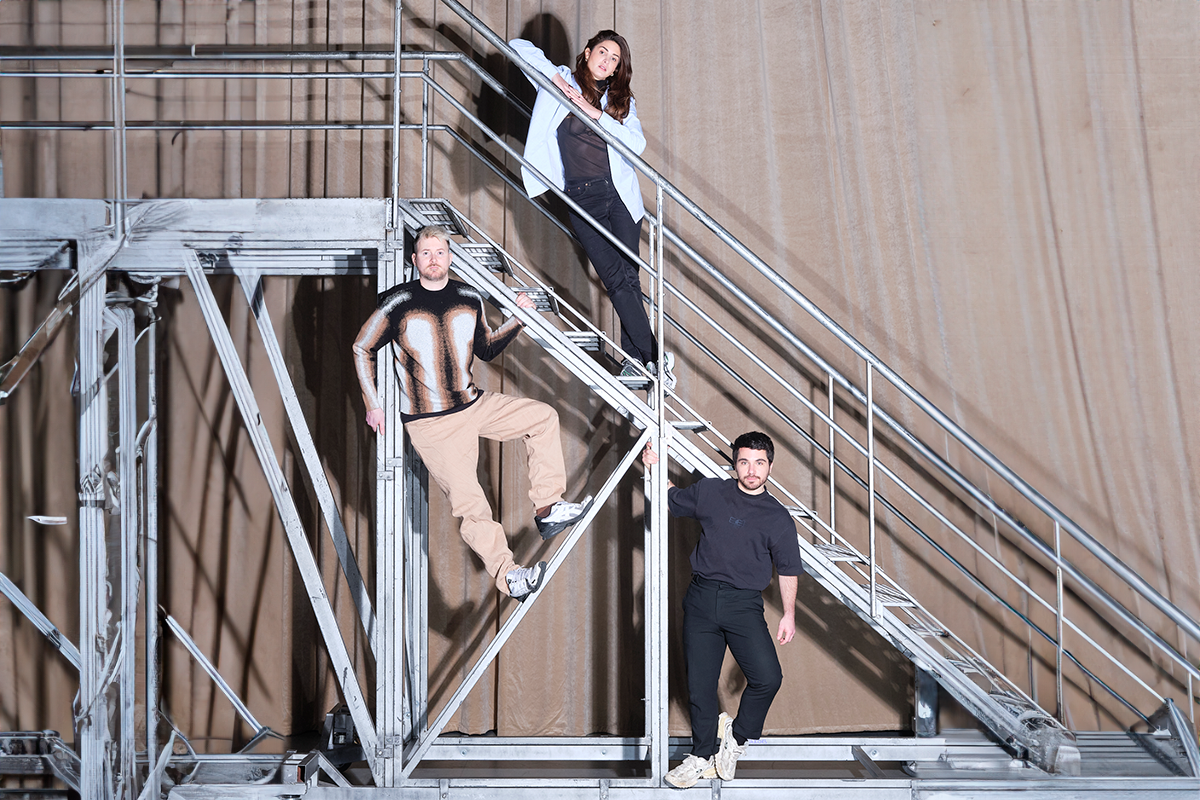Opening hours
:::
2025/09/30
(LA)HORDE: A Body Revolution Reconstructing Internet Dance Within Traditional Ballet
Text by Tammy Wang / Talk by Xiang Jun Fan
(LA)HORDE was founded in 2013 by Marine Brutti, Jonathan Debrouwer, and Arthur Harel. Their creative practice spans dance, film, video installation, and performance. Brutti and Debrouwer both graduated from the Strasbourg School of Decorative Arts, where they studied video and performance art, while Harel studied theatre and dance at the Conservatory of Dramatic Art in Paris’s 6th arrondissement. The trio first met at queer gatherings and nightclubs in Paris before deciding to form a collective. The name “HORDE” evokes images of a tribe, a crowd, or an unruly mob. It reflects their patchwork mode of working—each member initiates individual projects that are later developed collectively. The feminine French article “(LA)” in parentheses signifies fluidity and an intentional refusal of fixed gender identities.
 French dance collective (LA)HORDE
French dance collective (LA)HORDE
The bodily practice of post-internet dance
“Post-internet dance” is a central concept in (LA)HORDE’s creative practice. In interviews, the collective noted that the Internet had always been their primary creative tool. When they first began making work, the Internet was far less saturated with censorship, advertising, and capitalist influence—it still felt like an open, boundless space. It was through the Internet that they discovered Jumpstyle, which led them to connect with a number of Jumpers. Together, they created Novaciéries (2015), a piece in which the dancers perform with their heads fully covered, resembling digital avatars that embody the fluid and ever-shifting nature of identity and representation. The work also integrates documentary-style footage of the dancers practicing in their everyday lives, transforming internet culture and the practice of the dancing body through artistic means. Musically, they intentionally detach the dancers’ movements from the soundtrack.
Later, they discovered that Jumpstyle dancers were watching videos of traditional Georgian dance online to learn spinning techniques. Intrigued, the three traveled to Georgia, where they met local Jumpstyle dancers and immersed themselves in the country’s nightclub culture. Georgian clubs, the stage for underground electronic music, appeared almost utopian to outsiders, offering a unique lens into humanity’s depths. This experience culminated in their 2019 work Marry Me in Bassiani.
A bodily declaration from the bedroom to the streets
Jumpstyle is a form of hardcore dance performed to high-energy music. It originated in Belgium before spreading to the Netherlands and beyond. Often described as “a bodily declaration from the bedroom to the streets,” Jumpstyle began with dancers practicing alone in their bedrooms, in front of mirrors, before moving into living rooms and garages. They would record themselves, upload the videos online, and eventually gather in streets and public squares to dance together and battle in real life.
The three artists of (LA)HORDE found the physical practice of Jumpstyle particularly fascinating. Unlike contemporary dance, which typically requires choreographing every move in the rehearsal room before presenting a polished product onstage, Jumpstyle exists outside institutional frameworks. It functions more like a diary or an online community, evolving from virtual dance battles to real-world gatherings. Jumpstyle emphasizes individuality. Each dancer develops their own distinctive technique. (LA)HORDE’s breakout piece, To Da Bone, centers on self-taught dancers from the post-internet era, presenting the journey of dance from intimate, private spaces to collective, public arenas.
Taking over the Ballet National de Marseille
The Ballet national de Marseille visited Taiwan in 1992 and performed The Sleeping Beauty and Ma Pavlova, both reimagined by then-artistic director and legendary French choreographer Roland Petit. Petit was renowned for his dramatic flair and cinematic approach to modern ballet. His iconic Pink Floyd Ballet, a direct collaboration with the rock band, underscored the close relationship between ballet and contemporary pop culture. This history reflects the company’s enduring openness and cross-disciplinary spirit.
A post-pandemic dance confession
Created during the pandemic in 2020, Room With A View marked (LA)HORDE’s first major production after joining the Ballet national de Marseille. Collaborating with French electronic music producer Rone, the piece centers on the concept of “collapse,” exploring and anticipating the potential for total or partial breakdowns of human civilization. Here, collapse is conceived as a complex systemic process encompassing climate change, ecological crises, socioeconomic inequality, unequal distribution of resources, geopolitical tensions, conflicts over resources, and the fragility of globalized supply chains and financial systems.
The stage is set in a dust-filled marble quarry, symbolizing the environmental destruction and exploitation resulting from human-driven resource extraction—an allegory for the planet’s decay and disintegration under the strain of overconsumption. Rone’s music plays a pivotal role, propelling the dancers’ bodies into states of intense and extreme physicality while exposing the raw edges of human desire and loss of control. At times, the movements appear violent, even evoking physical discomfort, yet they also carry a redemptive force and an eruption of collective energy that compel the audience to confront apocalyptic darkness while simultaneously igniting an alternative imagination of hope.